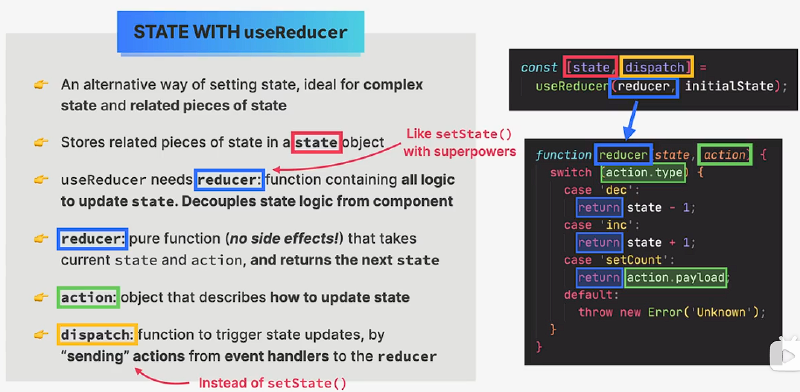状态变量是React保持UI与数据同步的重要方式。本次我们会学习使用React库中的Reducer钩子和React Context API上下文来管理状态变量,消除之前组件中的大量无用道具。我们还要学习使用新版本的Redux进行状态管理。
Reducer 钩子
随着项目的增大,仅使用State及其setState函数来管理状态显得力不从心。这时,使用Reducer钩子可以让我们在代码的某处统一管理状态。

简单来说,若是多种状态变量产生了交涉,即某种状态变量的更新需要另一种状态变量,我们就应该考虑使用更专业的状态管理工具。
使用方法

我们使用useReducer钩子创建state状态变量及其其设置函数dispatch。我们将state的初始值设置为一个对象,并在其中包含需要管理的各种状态变量。
然后,我们在自定义的reducer函数中设置对各种action的处理方法。
在开发过程中,我们通常对action进行封装,以区分action中的不同种类(type和payload)与载荷。
最后,我们在页面中取出当前的state并使用。


实际的代码中,我们使用dispatch而非原先的setState函数作为handler。其会触发reducer内的相关处理,并最后和state一样造成页面重渲染。
useReducer与useState


Context API
在之前的开发中,我们简单地使用props来传递不同组件之间的状态变量,这导致组件中包含大量的冗余道具,影响了代码的可读性。一种解决方法就是使用Context API来全局地传递状态变量到需要的组件当中。

作用原理

使用方法




实际开发中,我们将上下文及其相关状态的新建等单独放置在一份js代码中,将上下文的value提前打包好。
1
2
3
4
5
6
7
8
9
10
11
12
13
14
15
16
17
18
19
20
21
| //PostContext.js
const PostContext = createContext();
function PostProvider({children}){
//add state in this component
//......
return (<PostContext.Provider value={{/*...*/}}>
{children}
</PostContext.Provider>
);
}
function usePosts(){
//warp 'useContext' hook
const context = useContext(PostContext);
if(context) return context;
else throw new Error("Outside of provider.");
}
export { PostProvider, usePost };
|
Redux
Redux是一个用来管理全局状态的第三方库,集成了常用的状态管理、全局状态结局方案,可以用作大型程序的状态管理工具。



Redux和Reducer相近,都使用dispatch作为操作变量的入口。它们的区别体现在Redux使用一个store来储存多种reducer,Reducer使用一个reducer来对应不同的动作。
使用方法
- 使用
Redux Toolkit的configureStore来创建store;
1
2
3
4
5
6
7
8
9
10
11
12
13
| import { configureStore } from "@reduxjs/toolkit";
import accountReducer from "./features/accounts/accountSlice";
import customerReducer from "./features/customers/customerSlice";
const store = configureStore({
reducer: {
account: accountReducer,
customer: customerReducer,
},
});
export default store;
|
- 使用
Redux-slice来创建store中的reducer切片。
1
2
3
4
5
6
7
8
9
10
11
12
13
14
15
16
17
18
19
20
21
22
23
24
25
26
27
28
29
30
31
32
33
34
35
36
37
| import { createSlice } from "@reduxjs/toolkit";
const initialState = {
fullName: "",
nationalID: "",
createdAt: "",
};
const customerSlice = createSlice({
name: "customer",
initialState,
reducers: {
createCustomer: {
prepare(fullName, nationalID) {
return {
payload: {
fullName,
nationalID,
createdAt: new Date().toISOString(),
},
};
},
reducer(state, action) {
state.fullName = action.payload.fullName;
state.nationalID = action.payload.nationalID;
state.createdAt = action.payload.createdAt;
},
},
updateName(state, action) {
state.fullName = action.payload;
},
},
});
export const { createCustomer, updateName } = customerSlice.actions;
export default customerSlice.reducer;
|
- 在程序中使用
useDispatch和useSelect来操作、读取状态变量。
1
2
3
4
5
6
7
8
9
10
11
12
13
14
15
16
17
18
19
20
21
22
23
24
25
26
27
28
29
30
31
32
33
34
35
36
37
38
39
40
41
42
43
44
| import { useState } from "react";
import { useDispatch } from "react-redux";
import { createCustomer } from "./customerSlice";
function Customer() {
const [fullName, setFullName] = useState("");
const [nationalId, setNationalId] = useState("");
const dispatch = useDispatch();
function handleClick() {
if (!fullName || !nationalId) return;
dispatch(createCustomer(fullName, nationalId));
}
return (
//...
);
}
export default Customer;
// account.js
import { useState } from "react";
import { useDispatch, useSelector } from "react-redux";
import { deposit, payLoan, requestLoan, withdraw } from "./accountSlice";
function AccountOperations() {
const [depositAmount, setDepositAmount] = useState("");
const [withdrawalAmount, setWithdrawalAmount] = useState("");
const [loanAmount, setLoanAmount] = useState("");
const [loanPurpose, setLoanPurpose] = useState("");
const [currency, setCurrency] = useState("USD");
const dispatch = useDispatch();
//use selector
const {
loan: currentLoan,
loanPurpose: currentLoanPurpose,
balance,
isLoading,
} = useSelector((store) => store.account);
//...
}
|
还可以使用中间件(Middleware)Thunk来在Reducer中引入副作用。
与Context API的比较


总的来说,Redux适合大型软件的开发,但是不够轻量化,使用难度也更高。我们需要根据异步操作和性能的需求来选择使用Redux或Context API进行状态管理。
状态管理总结
对SPA来说,可以归纳出以下四种状态变量:
- 本地状态,仅在某些子组件中存在;
- 全局状态,被大部分子组件使用;
- 远程状态,需要从外部API获取;
- UI状态,除远程状态外的状态。

我们可以使用不同的工具,针对不同的状态进行管理。




















